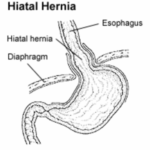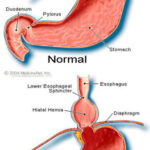Although umbilical hernias are usually associated with infants and very young children, adults can have an umbilical hernia gradually become larger, necessitating surgery to repair the hernia opening. In November 2009, I found myself in that position. After my surgery, I was given a list of things I could and could not do and things I was to watch for. Some tips were suggested by friends and the surgeon’s associate and were not on the list.
Umbilical Hernia Surgery Care Tips: The Release and Drive Home
Even though I was instructed ahead of time that umbilical hernia surgery was a day surgery, I was not prepared for how quickly I was released from the hospital. I felt nauseous and dizzy for the rest of that day, most likely a side effect from the anesthesia used. I gladly accepted a ride in the wheelchair to the car but dressing and then moving from the hospital bed to the wheelchair was very painful. My husband had already indicated he would drive me home since I would not be allowed to drive until two weeks after my surgery. On the way home, I reclined my seat so I could rest.
My suggestions: Prearrange for someone to drive you home. Do not attempt to get up from the hospital bed without assistance. Make sure you have someone escort you by wheelchair to your vehicle. If possible recline your seat to lessen any nausea and dizziness.
Umbilical Hernia Surgery Care Tips: Pain
My husband got my pain medications filled at the pharmacy after we left the hospital. As soon as I got home, I donned a loose-fitting nightgown and crawled slowly into bed. My abdomen around my bandaged and taped navel felt as though the surgeon and his assistants all took turns punching me in the belly. That feeling was to stay with me for the next three or four days. I took my prescribed pain medication through the rest of the day and found all I wanted to do was to sleep.
My suggestions: If pain medications are prescribed, have someone get the prescription filled before you leave the hospital, if possible. Wear loose-fitting clothes for about twenty-four hours after your umbilical hernia surgery. Get plenty of bed rest. Have someone with you to help you to the bathroom and serve you for the first day. Take your prescribed pain medication as needed.
Umbilical Hernia Surgery Care Tips: Diet
When I finally felt as though I could eat something, my husband served me some clear juice. He followed that with chicken bouillon in hot water and saltine crackers. I did not have anything like coffee, milk, orange juice, or other solid foods until the next day after my umbilical hernia surgery. A special after-surgery diet is not required. Because you should not strain in the days after your surgery, you should eat a diet which will prevent constipation. Fresh fruits and vegetables, whole grain products, and plenty of fluids including water should be helpful. Just in case, you can have a laxative or stool-softening medications ready.
My suggestions: If you feel nauseous, take your time getting back to your normal diet. Start with easy-to-digest liquids and foods. Make sure your diet is fiber-rich and includes enough fluids to keep your bowel movements regular. The last thing you want to do is to delay your recovery by straining your abdominal muscles.
Umbilical Hernia Surgery Care Tips: Rolling Over
I am not a back sleeper. I prefer lying on my left side to sleep and my right side to read. During the night, I roll over frequently. In the week following my umbilical hernia surgery, any movement to roll over felt as if I was going to spill the contents of my abdomen onto the bed. Movement meant pain. A friend recommended having a firm bed pillow with me in bed to hold against my abdomen as I turned over. The pillow provided a degree of support. Two days after my surgery, I began to wear loose sweat pants or flared skirts to prevent discomfort from too-tight waistbands.
My suggestions: Have a bed pillow with you when sleeping to help you roll over during the night. Wear pants or skirts with loose-fitting waistbands which will not chafe at the site of your surgery. The key is comfort.
Umbilical Hernia Surgery Care Tips: Watch for Signs
As with any open wound or surgery site, you must watch for signs of infection or re-injury. With the type of surgery I had, involving placement of a mesh over the umbilical tear, there was a small risk that my body would reject the foreign mesh. I was to watch for elevated temperature, excessive bleeding as evidenced by a blood-soaked gauze dressing, red streaking of the skin extending outward from under the dressing, or any bad smell coming from the dressing. None of that occurred with my hernia surgery site except for a little more bleeding than I thought I should have after I became more active the third day after surgery. I rested and the bleeding slowed and stopped.
My suggestions: Know the signs of infection or re-injury. If any of the symptoms occur, call your local clinic. Be able to explain exactly what you are experiencing. The nurse on call will either instruct you to come in to have it further checked or tell you what to do. If the surgical site seems to be bleeding more than it should, see if rest will slow it.
Umbilical Hernia Surgery Care Tips: Bathing, Showering, and the Unveiling
I had been instructed upon my release from the hospital to refrain from showering for at least two days. The gauze dressing was to be kept dry. For that reason, I took sponge baths instead of a tub bath for the first week after surgery. When I showered I was to pat the surgical area dry with a towel.
Even though I was allowed to remove the dressing and cotton wadding from inside my navel after three days, I waited for about a week until my husband could assist me. We had sterile medical gauze and flexible medical tape on hand to cover the surgical area after the unveiling of my reshaped navel. This was to prevent infection and irritation from my clothing rubbing against it. The internal surgical area was still raw and weepy and the stitched opening, about one and a fourth inches in length, under my navel was not yet healed over. But for the first time since 1996 when our last daughter was born I had a navel which did not protrude like a ping pong ball. That made me smile.
My suggestions: Follow the nurse’s directions about keeping the bandaged area dry. When you are allowed to shower, bathe, or remove the dressing is based upon the type of incision the surgeon made for your umbilical hernia repair. Until you can shower, take a sponge bath using a basin of water and a washcloth. If you can not handle the initial sight of your surgery, have someone stand by to help you. Have sterile medical gauze and tape at hand for covering the surgical area, if desired.
Umbilical Hernia Surgery Care Tips: Prolonged Weepiness
I noticed after one and a half weeks that one small part of the external incision seemed a little “goopy” with a greenish-yellow discharge. The interior of the navel seemed to be somewhat moist. My husband’s inclination was to apply hydrogen peroxide which he believed would dry up the area. A few days later I asked the surgeon’s associate during our follow-up visit what I could do. She gently swabbed the inside of my navel and found the same discharge. Her first words were “Don’t use hydrogen peroxide.” Upon later research, I found that the Centers For Disease Control notes that hydrogen peroxide can irritate mucous membranes and skin and can be corrosive in higher concentrations.
Instead, the associate gave me a sample pack of three povidone-iodine swabs. Povidone-iodine is a brownish-orange antiseptic applied to the patient’s skin before an incision is made. The packaging says it is also useful as a first aid antiseptic for minor burns, cuts, and abrasions. She told me I was to gently clean the navel area with a cotton swab, then apply the 10 percent povidone-iodine solution to the inside and outside of the navel once a day until the incision dried. Povidone-iodine does stain clothing so after application I had to allow the area to dry before I could put clothes over it. Within two days, the incision was dry.
My suggestions: If your incision seems to remain moist and raw after a week, do not use hydrogen peroxide on it. Ask your doctor what he would suggest. He may suggest an antiseptic like povidone-iodine. Povidone iodine solution may be purchased by the bottle in discount stores like Target, Walgreen’s, and WalMart.
Umbilical Hernia Surgery Care Tips: Lifting and Healing
I was instructed not to lift anything weighing more than two or three pounds for two weeks and to restrict strenuous activity or heavy lifting for six to eight weeks. The surgeon’s associate told me surgical procedures can take up to two years to fully heal.
My suggestions: Even if you are feeling like you could lift 200 pounds within a week after your surgery, it is best to err on the side of caution and follow your physician’s instructions to prevent a recurrence. When you start to return to your normal exercise routine, work slowly over a few weeks until you are back to your optimal performance.
With special attention to your doctor’s instructions and using a few of these care tips, you will recover from your umbilical hernia surgery.
Resources
http://hcd2.bupa.co.uk/fact_sheets/html/umbilical_hernia_adults.html#5 Adult Umbilical Hernia Surgery Fact Sheet
http://www.healthline.com/galecontent/umbilical-hernia-repair/3 After Care for the Umbilical Hernia Surgery
http://www.atsdr.cdc.gov/Mhmi/mmg174.html CDC Statements About Hydrogen Peroxide







